
Sub-Zero is a title used by two characters in the Mortal Kombat fighting game franchise by Midway Games and NetherRealm Studios. They are depicted as two Chinese brothers and ninja warriors of the Lin Kuei clan, principally defined by their blue attire and ability to control ice in many forms. Both incarnations of Sub-Zero are the only series characters to have appeared in every main installment of the series, in addition to being featured as the protagonist of the 1997 spin-off Mortal Kombat Mythologies: Sub-Zero.
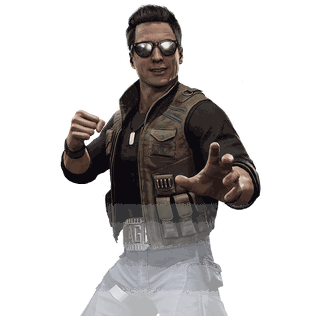
Johnny Cage is a character in the Mortal Kombat fighting game franchise by Midway Games and NetherRealm Studios. Introduced in the original 1992 game, he is an action movie star with an extensive martial arts background. The series depicts Cage as one of the primary heroes defending Earthrealm from various threats, as well as the comic foil. In the rebooted timeline, Cage is also the love interest to Special Forces officer Sonya Blade and the father of their daughter Cassie. He is inspired by martial arts star Jean-Claude Van Damme, particularly Van Damme's character, Frank Dux, in the 1988 film Bloodsport. A staple of the franchise, Cage has appeared in various media outside of the games.
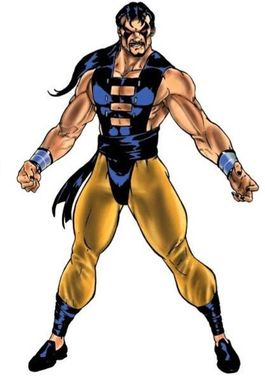
Shang Tsung is a fictional character in the Mortal Kombat fighting game franchise by Midway Games and NetherRealm Studios. He debuted as the final boss in the original 1992 game and has remained one of the franchise's primary villains. A powerful sorcerer, he is principally defined by his abilities to shapeshift into other characters and to absorb the souls of defeated warriors. Shang Tsung is usually portrayed as the right-hand man of Outworld emperor Shao Kahn and the archenemy of Shaolin monk Liu Kang. He also appeared as the main villain of Mortal Kombat: Deadly Alliance (2002), alongside Quan Chi as the eponymous Deadly Alliance, as well as in Mortal Kombat 11: Aftermath (2020) and Mortal Kombat 1 (2023).

Ermac is a character in the Mortal Kombat fighting game franchise by Midway Games and NetherRealm Studios. Debuting as an unlockable character in Ultimate Mortal Kombat 3 (1995), he is an amalgam of the souls of deceased warriors and possesses telekinetic abilities.

This is a list of playable and boss characters from the Mortal Kombat fighting game franchise and the games in which they appear. Created by Ed Boon and John Tobias, the series depicts conflicts between various realms. Most characters fight on behalf of their realm, with the primary heroes defending Earthrealm against conquering villains from Outworld and the Netherrealm. Early installments feature the characters participating in the eponymous Mortal Kombat tournament to decide their realm's fate. In later installments, Earthrealm is often invaded by force.

Kitana is a character in the Mortal Kombat fighting game franchise by Midway Games and NetherRealm Studios. Debuting in Mortal Kombat II (1993), she is a royal from the fictional realm of Edenia. She uses steel fans as her primary weapon.
Kung Lao is a character in the Mortal Kombat fighting game franchise by Midway Games and NetherRealm Studios. He debuted in Mortal Kombat II (1993) as a Shaolin monk and close friend of series protagonist Liu Kang, and his trademark characteristic is his wide razor-brimmed hat that he uses as a weapon. Kung Lao is depicted as one of the series' primary heroes, including a main role in the action-adventure spin-off Mortal Kombat: Shaolin Monks (2005).

Kenshi Takahashi is a character in the Mortal Kombat fighting game franchise by Midway Games and NetherRealm Studios. He makes his series debut in Mortal Kombat: Deadly Alliance (2002) as a blind swordsman and Special Forces operative. In addition to his sword skills, he possesses telekinetic abilities.
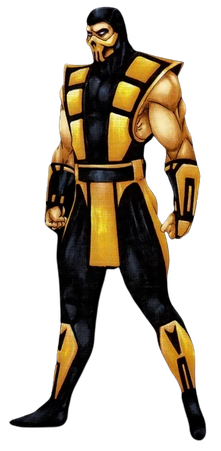
Scorpion is a character in the Mortal Kombat fighting game franchise by Midway Games and NetherRealm Studios. A ninja dressed in yellow, his primary weapon is a kunai rope dart, which he uses to harpoon opponents. Since his debut in the original 1992 game, Scorpion has appeared as a playable character in every main installment except Mortal Kombat 3 (1995).

Mortal Kombat II is a fighting game originally produced by Midway for the arcades in 1993. It was ported to multiple home systems, including MS-DOS, Amiga, Game Boy, Game Gear, Sega Genesis, 32X, Sega Saturn, Super Nintendo Entertainment System, and PlayStation only in Japan, mostly in licensed versions developed by Probe Software and Sculptured Software and published by Acclaim Entertainment.

Reptile is a character in the Mortal Kombat fighting game franchise by Midway Games and NetherRealm Studios. He debuted in the original 1992 game as a hidden opponent, establishing him as the first secret character in fighting game history. Reptile became playable in the follow-up Mortal Kombat II (1993) and has remained a mainstay of the franchise. As implied by his name, he is a Saurian, a fictional species of reptilian humanoids. One of the last surviving members of his race, he aligns himself with the series' primary villains in the hope his service will lead to the Saurians' revival.

Sonya Blade is a fictional character in the Mortal Kombat fighting game franchise by Midway Games and NetherRealm Studios. She debuted in the original 1992 game as the roster's sole female fighter, a military officer with the Special Forces. In the storyline of the games, Sonya becomes involved with the eponymous Mortal Kombat tournament through pursuit of her archenemy, the criminal leader Kano. She subsequently joins the warriors defending Earthrealm and establishes a government agency dedicated to battling otherworldly threats. The series' rebooted timeline also depicts her as the love interest to martial arts actor Johnny Cage and the mother of their daughter Cassie. A mainstay of the franchise, Sonya has also appeared in various media outside of the games. Reception to the character has been generally positive, with respect to her role as one of Mortal Kombat's primary female fighters. Though, some of her outfits in the games have received criticism.

Mortal Kombat: Special Forces is a 2000 action-adventure beat 'em up video game developed and published by Midway for the PlayStation in 2000. A spin-off of the Mortal Kombat franchise, it is the second installment to not be a fighting game and the first 3D spin-off. Set before the first game Mortal Kombat, players control Jax as he pursues criminal leader Kano and his gang.

Ed Boon is an American video game programmer, voice actor, and director. Boon was employed for over 15 years at Midway Games. Since 2011, he has worked for Warner Bros. Interactive Entertainment for one of its Subsidiaries, NetherRealm Studios.

Mortal Kombat: Shaolin Monks is a 2005 action-adventure beat 'em up video game developed and published by Midway for the PlayStation 2 and Xbox. A spin-off of the Mortal Kombat franchise, it is a retelling of the events of Mortal Kombat II (1993). Players control the eponymous Shaolin monks Liu Kang and Kung Lao in either single player or cooperative play as they protect Earthrealm from the forces of Outworld.

Mortal Kombat is an American media franchise centered on a series of fighting video games originally developed by Midway Games in 1992.
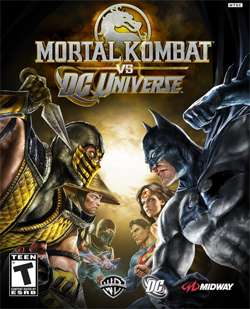
Mortal Kombat vs. DC Universe is a 2008 fighting video game developed and published by Midway Games for the PlayStation 3 and Xbox 360. The game is a crossover between Mortal Kombat and the DC Universe, and is the eighth main installment in the Mortal Kombat franchise. The game was released on November 16, 2008.
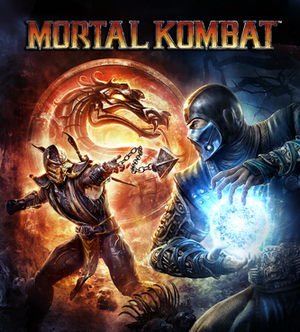
Mortal Kombat is a 2011 fighting game developed by NetherRealm Studios and published by Warner Bros. Interactive Entertainment. It is the ninth main installment in the Mortal Kombat series and a soft reboot of the series. The game was released for the PlayStation 3 and Xbox 360 systems in April 2011, and a PlayStation Vita port was released in May 2012. An expanded version of the game, titled Mortal Kombat: Komplete Edition, was released for Xbox 360 and PlayStation 3 in February 2012 and for Microsoft Windows in July 2013.

Liu Kang is a fictional character and the main protagonist in the Mortal Kombat fighting game franchise by Midway Games and NetherRealm Studios. Depicted as Earthrealm's greatest warrior and champion, he debuted in the original 1992 game as a Shaolin monk with special moves, which were intended to be the easiest for players to perform. Since his introduction, Liu Kang has appeared as playable in every main installment except Mortal Kombat: Deadly Alliance (2002). He is also one of the protagonists of the action-adventure spin-off Mortal Kombat: Shaolin Monks (2005).

















